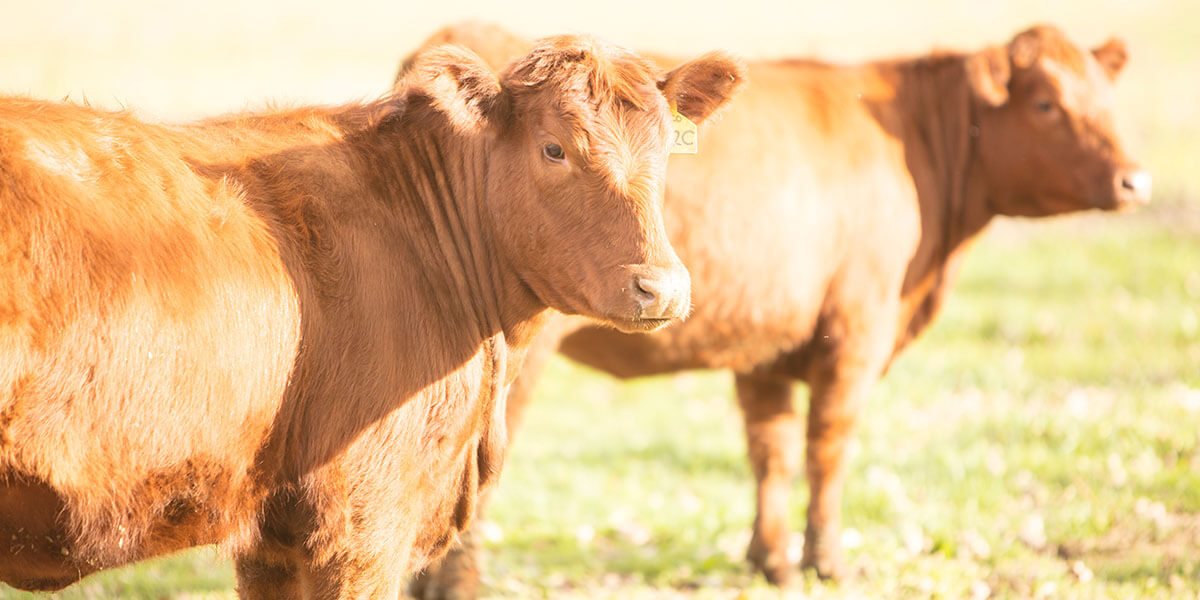Bovine respiratory disease (BRD) is a major challenge for cattle producers and can cause significant losses in performance, health and profitability. Research shows that BRD is responsible for 80% of the deaths that occur in calves entering commercial feed yards. In addition, it is estimated that BRD impacts the economics of the beef cattle industry with $800 to $900 million USD in annual losses, plus $110 million is lost each year in processing sick animals.
When a calf contracts BRD – at any point in the production cycle – they will need to play the catch-up game. BRD is destructive, but by working together to protect their wellbeing, we can position cattle for healthy, productive lives that drive profit further.
Cattle Production Factors that Contribute to Bovine Respiratory Disease
BRD is a multifactorial infection with viral and bacterial diseases working together against the calf’s immune system. Oftentimes a viral pathogen invades the animal and suppresses the immune system, creating the opportunity for various BRD bacteria to take over. Factors that put cattle at higher risk of contracting BRD include:
- Suboptimal nutrition: An animal that is not receiving adequate energy, protein or trace minerals in their ration will have a weak immune response.
- Depleted nutrients: Stress events deplete a calf’s stores of trace minerals, vitamins and other essential nutrients that are critical to a functioning immune system.
- Unvaccinated animals: A calf that has not been vaccinated is at a higher risk of BRD after four or five months of age.
- New environment: Stress occurs when moving to new locations, co-mingling and adjusting to new rations.
- Harsh weather: Cold rain, mud, high winds, dust or cold temperatures cause stress and weaken the immune response.
Reduce the Need for BRD Treatment During Each Phase
Reproduction
Nutrition can protect cattle from BRD and reduce the likelihood of a case occurring before a calf hits the ground. Cows fed Zinpro® Availa® 4 had calves that were better equipped against BRD because of:
- Pull-through response: Calves born to these cows had a significant reduction in BRD treatment rates in the feed yard with 20% of those calves being treated for BRD, compared to 42% of calves from cows with no supplementation.
- Better colostrum: Cows produce more, higher-quality colostrum. A 28% increase in immunoglobulin (IgG) content establishes stronger passive immunity as the calf develops its immune system.
Weaning
Reducing weaning stress will improve immune response and make the most of a herd health plan by increasing the effectiveness of vaccines. Best practices for weaning management include:
- Balanced nutrition: Provide calves with free choice Zinpro® Performance Minerals® while they are on the cow to aid their ability to mount a rapid and robust immune response following pre-weaning vaccination.
- Vaccination timing: Plan to vaccinate calves twice, two to four weeks apart, during weaning. A second dose of the same vaccine stimulates a higher level of antibody production that protects against BRD.
- Prevent nutrient loss with a trace mineral supplement: During stress events, a calf’s nutrient stores are often depleted causing a dip in immunity. Zinpro® ProFusion® works to replenish essential trace minerals and nutrients depleted during weaning stress.
- Low-stress handling: Keep calves calm and practice low-stress cattle handling techniques.
- Fence line weaning: Weaning calves at the fence line adjacent to the cows is far less stressful compared to off-site weaning. Ensure the calf and the cow can see each other, communicate and touch nose-to-nose.
Receiving and Finishing
BRD loss is a consistent threat in the feedlot. Strategies to ensure a successful transition that sets cattle up for a healthy, profitable finishing period include:
- Restore lost nutrients: Transportation and arrival stress initiates a reduction in feed intake and results in lost nutrient stores – setting them back upon arrival, requiring additional time to acclimate. Administering Zinpro ProFusion upon arrival restores trace mineral status within 48 hours and supports immunity as calves acclimate.
- Vaccination: Vaccinate between one and four days after entering the feedlot to further fortify their immune system.
- Ancillary therapy: When used as ancillary therapy for respiratory disease, Zinpro ProFusion can reduce case-fatality rate up to 23%.
- Stocking rate: Avoid overcrowding and provide at least 120 sq. Ft. (11 sq. m.) per animal — and allow more space if pen conditions are wet.
- Consistent nutrition: Provide a consistent immunity boost in the ration with Zinpro® Availa® Zn to support strong health through finishing and increase carcass yields.
Take a Proactive Approach with Zinpro Performance Minerals and Zinpro ProFusion
By focusing on management and proper beef cattle nutrition that is designed to help combat health challenges, you can protect the wellbeing and value of every pen. Combining Zinpro Performance Minerals and Zinpro ProFusion into a holistic disease management strategy provides a solid foundation to restore and maintain essential nutrition components that are critical to calf immunity. Equipping your cattle to stimulate a natural immune response when a BRD challenge arises is a more cost-effective approach than treating after the disease has taken hold. From conception to finishing, Zinpro partners to uphold the commitment you make to every calf. Each calf represents a significant investment and through proven nutrition and effective management, you can support healthier cattle capable of stronger performance and returns.
Connect with one of our beef experts to learn how you and Zinpro can work together to implement a proactive, holistic health plan.

